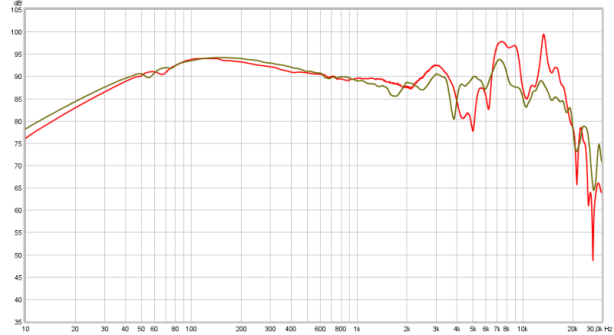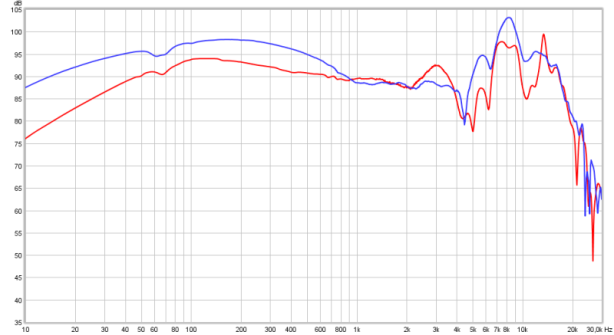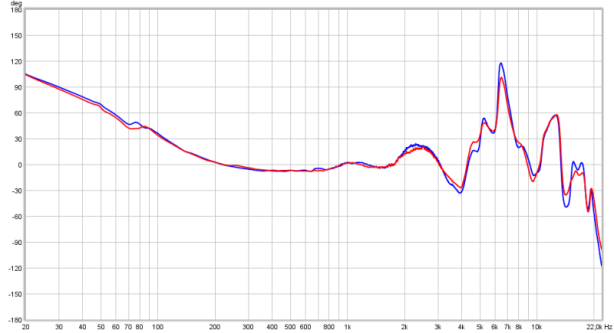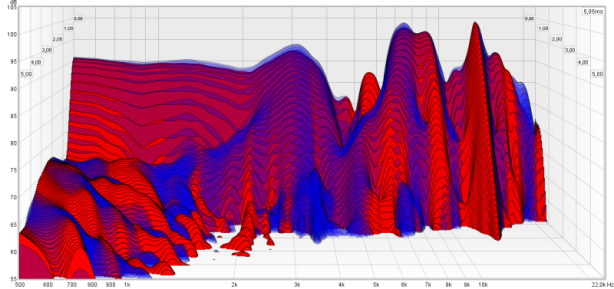HD570 Symphony
back to Sennheiser
back to measurements
home
published: May-22-2021, updated: Dec-13-2021
NO SMOOTHING is applied to the shown plots. Most measurement sites have some smoothing applied which ‘irons flat’ sharp peaks and ‘wiggles’. I do not use smoothing because some info about sound quality is lost when plots are smoothed.
Aside from a small correction of the microphone itself also some correction in the lowest frequencies is applied to the plots to compensate for the perceived loss of bass when using headphones. This is described HERE in more detail.
A ‘horizontal‘ frequency response curve on the shown frequency response plots on this website thus indicates a perceived ‘flat’ tonal signature.
ALL measurements are made with a good SEAL on a flatbed measurement rig.
The shape of your head, bone structure, pad size, pad ‘softness, (compliance), hair or no hair and or wearing glasses may (drastically) change the frequency response of some headphones, so… your personal experience may differ substantially from these plots.
Frequency response (tonal balance) is the most sound-determining aspect of headphones. A horizontal line shows audible neutral response in the plots on this website. Deviations in different severities at different frequency bands have an effect on the sound character.
The bigger the deviation the stronger the effect.
Below an aid to help determining the sound character of headphones with relation to the frequency response.

Sennheiser HD570 Symphony

The Sennheiser HD 570 is an open over-ear headphone. When this headphone came out (1998) it sold for around € 100.-. There was a small line with similar shaped headphones HD500 Fusion, HD575 and the $350.- HD590 prestige.
It comes with a thin 3m detachable cable which has a 3.5mm plug with a push on 6.3mm adapter.
The cable is not microphonic so in quiet passages and silences the cable rubbing against clothes is barely audible in the left cup.
The headband is soft and comfortable and so are the velours pads. When I got this the foam filling inside the headband as completely gone (sticky black stuff remained). Fortunately the headband can be removed and easily re-filled with foam. Also the foam in front of the driver was decayed. The pads still feel firm.
There is enough room for most ears. Height adjustment and tilt of the cups is large enough to suit most head sizes well.
The clamping force is ‘low’ but because of the low weight it won’t move around on the head easily.
The velour pads are exchangeable and all black. The original pads can still be ordered.
One does NOT have to worry about seal being essential for bass reproduction.
The cups can swivel far enough sideways but the vertical tilt is a bit limited. The headband can not be extended over a wide range so it may be difficult to get a good fit with larger heads.
The 3m long cable is connected via a 2.5mm TRS connector into the left cup. It fits snugly in the headphone so won’t be janked out easily by accident. The long cable indicates that this headphone is primarily intended for home/desktop usage. Very low in microphonics and has a 3.5mm plug with a 6.3mm adapter.
With a sensitivity of around 102dB/V the HD570 can not be used directly from a phone and reach high enough levels for normal music listening. To reach impressive levels it needs a bit more voltage than a phone, tablet or USB dongle. This headphone is not very sensitive so requires an amplifier to reach higher listening levels.
Note: I bought this headphone second hand.
The reviewed and filter modified HD570 symphony is up for sale.
specifications:
Type: Over ear, open
Usage: Home, studio
Driver type: dynamic
Pads: replaceable, velours
Collapsible: No
Headphone cup connector: Sennheiser 2.5mm TRS jack
Cable entry: single sided, left cup
Cable: 3m terminated in a 3.5mm TRS jack with a 6.3mm adapter
Driver size: 38mm (36mm membrane)
Inner Pad dimensions: depth = 21mm, Width = 45mm, height = 70mm, egg shaped
Max. power rating: 0.1W
Max. voltage: 2.6Vrms (7.5Vpp)
Max. current: 40mA
Max. S.P.L.: 110 dB
Impedance: 70 Ω (measured)
Efficiency: 90dB @ 1mW
Sensitivity: 102dB @ 1V
Weight: 210 g. (excl. cable)
Clamping force: low (3N)
Subjective sound description:
Bass and mids are on the warm side of neutral. The midrange can have a ‘sharp’ and ‘coarse’ character with certain recordings. Treble quality isn’t top notch either. It is a bit accentuated and lacks finesse.
It sounds like a lower quality HD599.
Measurements:
Below the frequency response of the HD 570 (Left, Right)

The channel matching is excellent, but that’s about all that is good about it alas. At least from a ‘hi-fi’ standpoint.
Bass is not well extended but present and does not feel ‘lacking’ and rolls off very gently below 40Hz. From 100Hz to 2kHz the response is linear and gently sloping (warm signature). At 3kHz there is a +4dB peak which can make voices sound ‘harsh/shrill’. The dip around 5kHz also does not help the sound. Then there is a substantial peak that can easily be lowered with 1 ply of 2- or 3-ply toilet paper. This does not affect the 3kHz peak though.
Lowering the treble peak makes the HD570 sound dull so it may be best to leave it as is to give the headphone a slight U-shape sound. The dips and peaks above 4kHz make the treble coarse and not very detailed.
comparisons
Below a comparative measurement of the HD570 compared to the current and more expensive bigger brother HD599.
Bass extension is the same. From 20Hz to 2kHz the headphones measure the same. Above 2kHz the emphasis at 3kHz, deeper dips and higher peaks make the HD570 sound a bit ‘brighter’ but also less ‘smooth’ and pleasant.
Below the HD570 versus the HD650
The HD570 is a bit ‘warmer’ and has a bit more lows than the HD650 but above 2khz the differences become obvious. There is no contest here. The HD590 may well be closer to the HD650.
Below the HD559 versus the well known DT990-250
 The DT990 also has an emphasis in the lows (U shaped sound) but is a bit higher.
The DT990 also has an emphasis in the lows (U shaped sound) but is a bit higher.
The treble peak of the DT990 is well known and is even higher than that of the HD570 but is ‘smoother’ and more detailed.
Below the HD559 versus the also well known DT880-250 Edition
The HD570 has more emphasis in the lows. The 3kHz peak is not present in the DT880. While the treble of the DT880 is elevated the peaks and dips are much smaller making the DT880 sound much smoother yet highly detailed.
Below the HD559 versus the Amiron home
The Amiron Home has much more lows/warmth and even higher treble. It is very V-shaped but here too the treble is still higher quality.
Phase response
Below the phase response of the HD570
Gentle sloping phase is not audible. Above 4kHz the phase changing within a narrow frequency band is more problematic.
output resistance / damping-factor
As this is a dynamic headphone the frequency response can be amplifier output resistance dependent when certain higher output resistance amplifiers are used.
Instead of showing impedance plots, which are hard to ‘read’ when it comes to assessing the tonal balance change in the real world, the HD559 is measured via a few different resistance outputs (0.2Ω, 10Ω, 33Ω and 120Ω). On a higher output resistance amplifier the output level will be lower of course due to voltage division. To compensate for this the amplifier is cranked up to the same level (8.2dB for 120Ω at 1kHz in this case). This way the plots are overlaid and it is easier to see how the tonal balance changes. Output resistances between the mentioned resistance values will result in tonal changes between those traces.

The tonal balance hardly changes when the HD570 is connected to a higher output resistance amplifier. The resonance frequency is around 100Hz resulting in a just very slightly warmer sound.
Seal can be an issue with closed-back headphones but is usually less of a problem for open headphones. Breaking the seal (improper fit on the head) usually means a loss of (sub)bass. Perfect seal, seal broken with a thick arm pair of glasses and seal substantially broken by slightly lifting the bottom of the pads which can occur when not properly seated.
 The HD570 is quite insensitive to a seal breach.
The HD570 is quite insensitive to a seal breach.
Below the distortion measurements of the HD570 (Right channel).
The plot above shows the level differences between the signal (upper trace around 90dB SPL) and the harmonics. Most people prefer to see percentages instead of level differences so below the exact same plot except ‘normalised’ to the actual signal and level differences given in percentages.

Distortion levels in the lowest frequencies are 2nd harmonic above 100Hz distortion drops below 1% which is kind of high. Also the 2nd harmonic distortion is still a bit high up to 1kHz. The distortion around 4.5kHz reaches over 1% but is a bit ‘misleading’ because of the dip there. Still around 1% in that range is potentially audible.
The actual 2nd harmonic distortion above 1kHz may well be lower than 0.2% . A shortcoming of my measurement rig.
Below the CSD (waterfall) plot of the HD570 . (Left and Right are overlaid)

No big red flags here. Only around 13kHz a clear resonance can be seen but is not worryingly ‘long’
Below the Group Delay plot for the HD570
There is some pad bounce at 70Hz. At just above 6kHz the resonance is visible. The ‘grass’ between 1 and 3kHz also shows up in the spectrum plot below.
A different plot is the spectrum plot. This basically is a CSD (Waterfall) plot but viewed from above where the level differences are colour coded instead of being in the vertical axis. Also the frequency range of the spectrum plot is wider (from 100Hz instead of 500Hz). The time span is also bigger in the spectrum plots and expired time is shown from below to top where in the CSD the time is shown from rear to front.
Below the spectrum plot of the HD570 (Right channel)
The plot shows short lingering in the lows, no obvious problems in the higher frequencies.
Step response
Below the step response plot which, when the sound is balanced and well extended should show a rise to around 0dB, (indicating fast driver response) and should be slightly sloping downwards indicating bass extension.
The lack of deep bass extension is visible as the horizontal trace drops quickly after 2ms. The ragged and elevated part in the first 500μs shows the sharp and coarse highs are dominant over the mids and lows.
reducing the treble
To reduce the treble (but not the 3kHz peak) a single ply of a 2- or 3-ply piece of toilet paper can be used.
The pads need to be removed as well as the foam (which probably needs replacement anyway).
Below the HD570 driver (the HD575 and HD590 have a different driver closer to that of the current HD6** range).
On the right side the driver with a single ply on top of the driver.
On top of that an AKG K240 foam disc is placed and the pads are pressed on again.
Below measurements with 1 layer and 2 layers pulled apart from 3-layer(ply) toilet paper vs stock.

The treble can easily be lowered with simple passive means. Alas the 3kHz peak is the most annoying part.
This was addressed with a passive filter. Below 2-ply + filter vs original HD570

Also with these modifications the treble is not refined and a bit coarse, just not as sharp sounding.
square-wave and impulse response
Below 40Hz and 440Hz square-waves and 100μs impulse response of the modified HD570, stimulus (and target) and measured response.

Conclusion
The HD570 is 20 year old headphone with a different ‘form’ than most other headphones (oval or round cups).
Only 4 of these similar shaped designs were made. Most likely this hasn’t caught on with the general public.
The HD500 and HD570 were not aimed at the audiophile crowd. The HD575 and HD590 might be more suited for serious listening.
These headphones are too insensitive to be used with portable gear. Also not really suited to listen to popular music.
For Classical music the sound signature isn’t really bad but there are, and were around 2000 as well, better headphones around.
A warmish but ‘sharp’ and ‘coarse’ sound signature. I haven’t seen the drivers that were used in this headphone in later models either. I guess the sales numbers were a bit disappointing.

Thanks for doing this review. I have had a thing for this generation of Sennheisers because of the headphone that kicked off my interest for audiophilia was the Hd590 that I bought used on ebay about 3 years ago. I still use them daily, even though I have “better” headphones. The genres that those shine the most in are Country and Blues, you might wanna give the hd570 a test with those.
The thing that my hd590 shine at is to extract and present that litte bit of hidden information in song or instrumental to set the mood, for example, the sense of pain in the voice of blues artist or the sense of whiskey smell in the ambiance, weird I know, might also be because me having had many glasses of whiskey listening to their sound, but no other of my headphones give the same sense of authenticity (also gives rum smell in flamenco music 🙂 ).
When experimenting with eq, the 3khz soft peak seems to be the one mainly responsible for this phenomenon.
If you want, I could send you a frequency response measurement of my hd590, I have based my measurement rig on yours.
Th HD590 has a very different driver. Closer to that of the HD575 I reckon.
I have made a 3kHz passive filter that removes the peak of the HD570 which removes the coarse/shouty sound. The dip after the 4kHz + slight peak around 6kHz still make the HD570 a little ‘poorer’ quality.
The 590 is very likely better in this area.
When you have a measurement of the HD590 and another headphone I measured I could have a look to see how the HD570 and 590 differ.
Unfortunately my headphone collection and yours seem to differ. The only one we both have are the pioneer se300, and I would not trust two copies of an exotic 70s headphone to give reproducible results
The hd590 was criticised back in the day for having a strong treble (I have never thought so though, but maybe I’m used to it). I have always believed that the main difference between these and the hd580/600 driver is the lack of a baffle infront of the driver, though I have never tested this.
Looking from the pictures of the HD590 it looks like the driver chassis is
the same as the current HD5** line and not the HD6** linecloser to the HD6** range. The price of the HD590 was similar to the HD6** range.Took some pictures of my hd590 drivers up close:
https://ibb.co/GWN6796
https://ibb.co/Yhng7Dx
I would say that appart from the long bridge that connects the drivers of the hd580/600 to the cable they look quite similar, however I remember that my old hd200 also had a very similar driver, might just be an older sennheiser aestetic design.
I can’t for the life of me find images of the hd575 driver so I can’t compare those.
When it comes to price, these and the hd600 was the best sennheiser had on offer back then (appart from Orpheus), so of course they were more expensive. At the end of their life they had come down to what the launch price of the hd595 was tho.
Yes, indeed looks a lot like a HD650 driver but different damping scheme. In HD650 driver about half of the paper on the rear is not present (covered by plastic) on the HD650 but looks like the same chassis.
HD575 also looks like HD6** based chassis
https://archiwum.allegro.pl/oferta/sennheiser-hd-575-i8883044141.html
Hi. This is quite unusual that you did this review more than 20 years after they were released. I just got mine out of storage and replaced the foams and I was looking to eq them using autoEq. Unfortunately they are not in the headphone database so I am out if luck. Maybe I can try to make an eq with REW but I don’t have the equipments to make the measurements of the frequency response. It would be nice if you could share it with me. I am not an expert but at least I can try something and give you back the resulting eq settings. Anyway. I am not surprised by the review as I also have the hd650 and they are much better in every ways.
I can make the HD570 REW file available. I have no idea how to generate EQ for that.
Nice that would be awsome. As I said I’m no expert but I can try. I already found some web sites that explain it.
contact me via the contact page (under tab ‘about’)
Hi. Thanks for the review. In it you state that the foam headband can be easily removed. How do you that? I have just replaced the inner pads, and put the outer pads in the washing machine with the dirty socks to get rid of 20 years of dirt (which worked really well), so I thought I’d try the same with headband, or replace it.
Thanks in advance.
OK, I got it. It is just clipped on, so, starting at one end just press the liner directly away from the plastic headband. It takes a little force, but once you get it going it is fairly easy.
Yes, once removed you can remove the cloth (it is ‘folded’ over) and remove all the gunk that once was foam.
When you put in new foam it has to be ‘shaped’ a bit otherwise it won’t look nice.